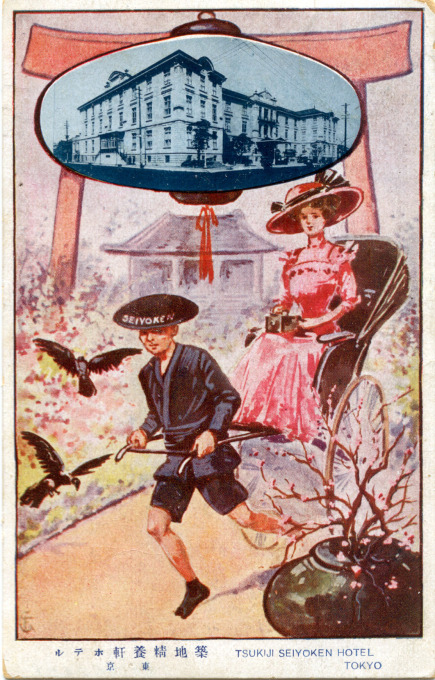See also:
Imperial Hotel (1890-1922)
Tsukiji Foreign Settlement, c. 1900
“Since the emperor’s arrival in Tokyo [in 1867], the Tsukiji Hotel had been entrusted with the task of furnishing European-style imperial banquets. The hotel opened in the summer of 1868 and for more than three years, before vanishing in flames with 5,000 other buildings in the neighborhood, it maintained the most exclusive Western-style restaurant in Tokyo.
“… In 1872 Tsukiji Seiyoken Hotel took over the responsibility of furnishing imperial banquets. It was the first high-class Western-style hotel in Japan that was owned and managed by a Japanese. Until the establishment of the Imperial Hotel in 1890, Seiyoken enjoyed the reputation of running the best Western restaurant in the capital.”
– Modern Japanese Cuisine: Food, Power and National Identity, by Katarzyna Joanna Cwiertka, 2006
The Tsukiji Seiyoken wasn’t Tokyo’s first Western-style hotel. (That honor went to the Hoterukan [hotel building], built in the first years of the Restoration but lost to the same 1872 conflagration that destroyed Ginza.) However, the Seiyoken was considered to be the capital’s finest hostelry in the years between the destruction of the Hoterukan and the completion of the first Imperial Hotel in 1890. The Seiyoken opened for business in 1872 in what was then the Foreign Settlement [kyoryuchi] at Tsukiji.
Fine European-style cuisine (with a Japanese flair) were among the firsts the Seiyoken introduced into Japan. New menu selections, for both Westerners and Japanese, included kare raisu [curry rice], tonkatsu [pork cutlet], and korokke [potato croquettes], all of which remain popular restaurant items to this day throughout Japan.
In 1899, the Foreign Settlement, which had been a public (and irritable) symbol of 19th-century foreign extraterritoriality (and of Japanese feudal xenophobia), was abolished; foreigners could from that time on reside anywhere in Tokyo. As a result, and coupled with the opening of the more centrally-located and partially imperial-financed Imperial Hotel, the importance of Tsukiji Seiyoken greatly diminished. However, a Ueno Park location was built in 1917 where its business as a popular restaurant and banquet hall remains there to this day. The Ueno Seiyoken was designed by Czech architect Jan Letzel who would also go on to be responsible for the Miyajima and Matsushima Park resort hotels, the interior of the Tokyo Station Hotel, and the former Hiroshima Prefectural Office that survives today as the “A-bomb Dome.”






Pingback: Tsukiji Foreign Settlement, c. 1900. | Old Tokyo
Pingback: Hotel Metropole (former US Legation), Tsukiji, c. 1905. | Old Tokyo
Pingback: Hotel Metropole (former US Legation), Tsukiji, c. 1905. | Old Tokyo
Pingback: Matsushima Park Hotel, Matsushima, c. 1920. | Old Tokyo
Pingback: Japanese curry, Officer’s mess, Battleship Mikasa, c. 1906. | Old Tokyo
Pingback: Imperial Hotel (1890-1922). | Old Tokyo
Pingback: Rikkyo (St. Paul's) University | Old Tokyo
Pingback: Після вибуху атомної бомби в Хіросімі частково вціліла будівля з куполом, після вибуху в Бейруті — елеватор. Обидві будівлі проектували че
Pingback: 우리나라 호텔의 역사 | 호텔리시스
Pingback: Teishin-sho (Ministry of Communications), Tsukiji, c. 1900. | Old TokyoOld Tokyo
Pingback: Roseta hoter [sic], Tokyo, c. 1910. | Old TokyoOld Tokyo